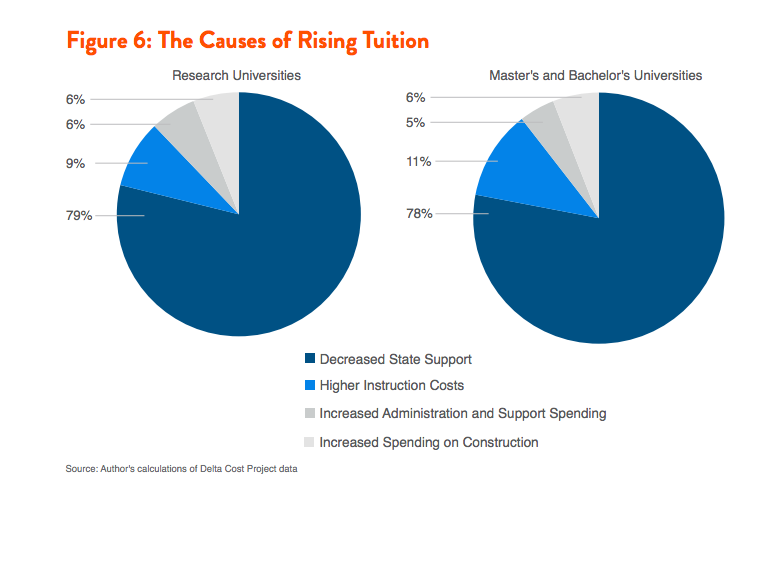States are Still Not Funding Colleges
By:
College tuition costs continue to skyrocket, and policymakers are looking for the culprit. But they could be looking in the wrong place.
A common explanation is so-called “administrative bloat.” It's true that colleges and universities are spending much more on administrators and professional employees. In the 25 years between 1987 and 2012, the number of professional staff in higher education has more than doubled—and while more students require more administrators, the growth in administration is far outpacing the growth in the number of students that universities have to support. Some have argued that this increase in administrative costs is substantially responsible for the huge increases in tuition.
But a new report from Demos, a public policy think tank, draws a totally different conclusion:
The operating theory behind “administrative bloat” is that universities have created a layer of unnecessary, self-sustaining bureaucracy—and if higher education institutions could be pressured into “trimming the fat” and purging unnecessary administrators, then tuition costs could be reined in. The report demolishes that idea in two ways: first, the number of executives and administrators has actually decreased in proportion to the number of students. The increase in personnel is actually due to more essential support staff in admissions, financial aid, IT and the like.
Unfortunately for the “administrative bloat” theory, increases in administrative staff is only responsible for a small portion of overall tuition increases. The vast bulk of it is the result of a massive divestment on the part of state governments:
Over the past decade, state support for research institutions fell by $3,081 and declined $2,067 at master’s and bachelor’s universities, in near-lockstep with tuition increases. Because education and related expenses are funded nearly entirely by tuition and state monies, declining state support has caused a dramatic shift in the share of these expenses paid for by students and the government.
 Demos - demos.org
Demos - demos.org
Demos’ analysis of spending and revenue data from universities suggests that a decline in state support is responsible for nearly four-fifths of tuition at public universities—over ten times the share of administrative staff increases.
This debate has real-world relevance. California Gov. Jerry Brown (D), for instance, is negotiating with the University of California over how to avoid tuition increases. Brown expects the university system to avoid tuition increases by learning how to be more efficient on the administrative end, while the Board of Regents is insisting that there’s no more fat left to trim and that any further budget reductions would start compromising educational quality. The Demos report indicates that the Regents might have the better case. In Louisiana, the state of affairs is even more dire. Louisiana Gov. Bobby Jindal has proposed "the biggest legislative downsizing" in higher education in U.S. history, according to The Atlantic. School officials say the decreases proposed by Jindal will amount to an 82 percent cut to the state's budget.
